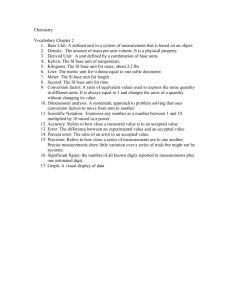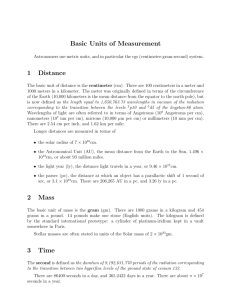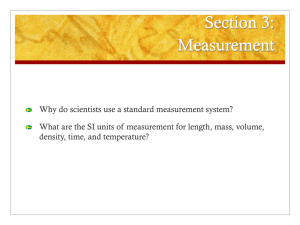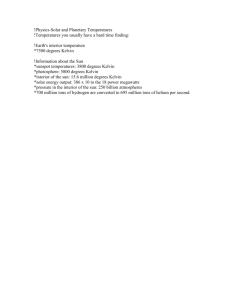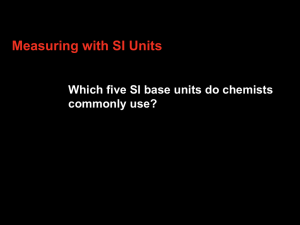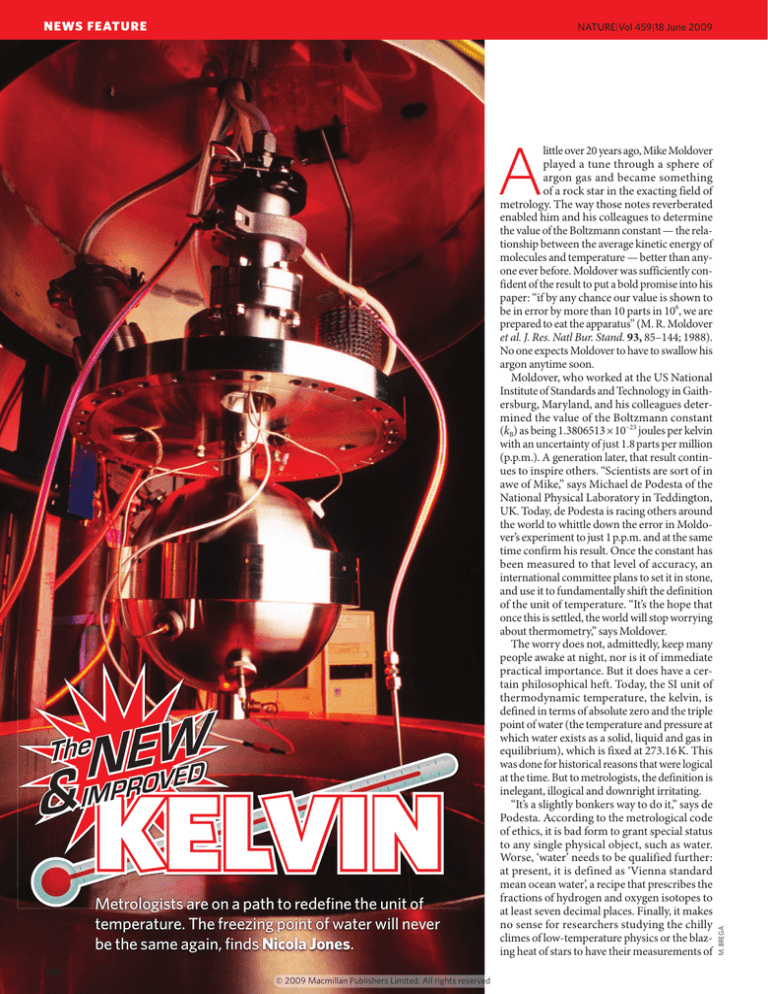
NEWS FEATURE
Vol 459|18 June 2009
NATURE|Vol
EROW
N
VED
P
IM
The
&
KELVIN
Metrologists are on a path to redefine the unit of
temperature. The freezing point of water will never
be the same again, finds Nicola Jones.
902
© 2009 Macmillan Publishers Limited. All rights reserved
M. BREGA
A
little over 20 years ago, Mike Moldover
played a tune through a sphere of
argon gas and became something
of a rock star in the exacting field of
metrology. The way those notes reverberated
enabled him and his colleagues to determine
the value of the Boltzmann constant — the relationship between the average kinetic energy of
molecules and temperature — better than anyone ever before. Moldover was sufficiently confident of the result to put a bold promise into his
paper: “if by any chance our value is shown to
be in error by more than 10 parts in 106, we are
prepared to eat the apparatus” (M. R. Moldover
et al. J. Res. Natl Bur. Stand. 93, 85–144; 1988).
No one expects Moldover to have to swallow his
argon anytime soon.
Moldover, who worked at the US National
Institute of Standards and Technology in Gaithersburg, Maryland, and his colleagues determined the value of the Boltzmann constant
(kB) as being 1.3806513 × 10−23 joules per kelvin
with an uncertainty of just 1.8 parts per million
(p.p.m.). A generation later, that result continues to inspire others. “Scientists are sort of in
awe of Mike,” says Michael de Podesta of the
National Physical Laboratory in Teddington,
UK. Today, de Podesta is racing others around
the world to whittle down the error in Moldover’s experiment to just 1 p.p.m. and at the same
time confirm his result. Once the constant has
been measured to that level of accuracy, an
international committee plans to set it in stone,
and use it to fundamentally shift the definition
of the unit of temperature. “It’s the hope that
once this is settled, the world will stop worrying
about thermometry,” says Moldover.
The worry does not, admittedly, keep many
people awake at night, nor is it of immediate
practical importance. But it does have a certain philosophical heft. Today, the SI unit of
thermodynamic temperature, the kelvin, is
defined in terms of absolute zero and the triple
point of water (the temperature and pressure at
which water exists as a solid, liquid and gas in
equilibrium), which is fixed at 273.16 K. This
was done for historical reasons that were logical
at the time. But to metrologists, the definition is
inelegant, illogical and downright irritating.
“It’s a slightly bonkers way to do it,” says de
Podesta. According to the metrological code
of ethics, it is bad form to grant special status
to any single physical object, such as water.
Worse, ‘water’ needs to be qualified further:
at present, it is defined as ‘Vienna standard
mean ocean water’, a recipe that prescribes the
fractions of hydrogen and oxygen isotopes to
at least seven decimal places. Finally, it makes
no sense for researchers studying the chilly
climes of low-temperature physics or the blazing heat of stars to have their measurements of
temperature rely, even theoretically, on com- with mercury and weighing it. (He promised of their work requires extreme care. “You buy
parison to a random piece of ice. “The kelvin in his paper to eat this, too, should his result be a very pure gas, which isn’t pure enough. So
you purify it more,” says Roberto Gavioso
is ripe for redefining,” says Richard Davis, one proved wrong).
of Moldover’s former colleagues, who works at
The volume issue remains the hardest from the institute in Italy, explaining just one
the International Bureau of Weights and Meas- problem to crack. Filling the spheres with a technical detail from a long, long list. One or
liquid and weighing them is still a possible all of the labs should hit 1 p.p.m. by the end
ures (BIPM) in Sèvres, France.
The BIPM, which is in charge of such things solution. But there is a more elegant method, of 2009 or 2010. “I’m cheering for these guys,”
as units, aims to fix this unconscionable situa- the details of which have just been worked out says Moldover who, now 69, has passed on the
tion by 2011. The Boltzmann constant, which is by one of Moldover’s original colleagues, James Boltzmann torch.
currently a measured value with some unceruncer
Mehl, professor em
emeritus at the University of
At the same time, the German National
tainty, will be declared a set
et number
Delaware in Newark. The idea is to fit the Metrology Institute in Berlin, heads an alter(letting it live up to its name
me of
sphere with tiny antennas to meas- native approach. Bernd Fellmuth’s kit consists
‘constant’) and the kelvin will
ure the
th resonance of microwaves of a pressure chamber surrounded by a cubic
be redefined as something
ng
in the cavity, then use this metre of water to keep the temperature conlike the change in ther-measurement
to determine stant. A set of capacitors inside the chamber
m
modynamic temperaturee
tthe sphere’s volume. The measures the capacitance before and after
“The kelvin is ripe
that results in a change of
rresearchers will deliberately helium is inserted, which allows the team to
for redefining.”
mean translational kinetic
use a lopsided sphere, such as calculate kB using a different set of equations
u
— Richard Davis
energy of 1.38065XX × 10−233
one with three axes of slightly from those used by the acoustic thermometry
o
joules — the current work
k
different lengths, to avoid the group. A difficulty here, however, is how to
d
will fill in the Xs.
complicated pattern of over- measure the pressure to the required accuracy;
com
lapping resonances that results currently that’s only possible to about 4 p.p.m.,
lapp
Sound science
from u
using a sphere approaching, and an entire team is required to reach that
The change represents a metrological
but not rea
reaching, perfection.
point. The group hopes to begin experiments
sleight of hand. Whatever uncertainty existed
“It needs to be very exactly not a sphere,” says in January 2010 that could get the accuracy
in the measure of the Boltzmann constant will de Podesta. To reach that kind of precision, he down to 1 or 2 p.p.m. by the end of that year.
be wiped clean by definition, and transferred uses the same manufacturers that are involved Moldover calls that an optimistic target, but it
to uncertainty in the measure of temperature. in producing the mirrors for the future James would be good to have a check for the acoustic
These new temperature uncertainties are so Webb Space Telescope.
work in time for 2011, he says.
tiny that they certainly won’t cause panic in
The effort to best Moldover has inspired
Once the results are in, the decision goes to
any lab — most researchers won’t even notice a friendly race between three main labora- an international vote. Each of the 53 nations
them. Instead the redefinition will open the tories: the National Physical Laboratory, the that are members of the BIPM supplies deledoor for improved accuracy at the far ends of National Institute of Metrological Research in gates to the General Conference on Weights
the temperature spectrum. More than that, it Turin, Italy, and France’s equivalent national and Measures, which will make the final decifrees the kelvin from an unsteady connection lab outside Paris. All three are using acoustic sion. This high-level conference meets once
to water and rests it on the intellectually firmer thermometry — although with slightly differ- every four years — the next being in 2011.
foundations of a physical constant. As such, ent apparatus — to determine kB. Every aspect
Why the rush to this finish line for the kelvin?
the move mirrors what metrologists are doing
with all the units of measurement.
In the case of the kelvin, the technique of
choice for determining kB is called acoustic
thermometry, and it relies on being able to precisely determine the speed of sound in a gasfilled sphere at a fixed temperature. From this
the Boltzmann constant falls out of the equations relating the kinetic energy (E) to the thermal energy of the gas (E = 1/2mv2 = 3/2kBT, in
which m is the mass of one atom, v is the average speed of the atoms — which is proportional
to the speed of sound in the gas — and T is the
temperature). The speed of sound can be measured by analysing the frequency of the sound
waves that resonate within the sphere. The
good news is that experimentalists can measure
the frequency with great precision; de Podesta
has a rubidium clock in his lab that’s accurate
to 1 part in 1013. The bad news is that to analyse
the resonances accurately, the volume of the
container must be known with great precision.
Moldover did this in his groundbreaking 1988
experiment by first filling his 3-litre sphere Michael de Podesta and his team is trying to lessen the error margin in measuring the Boltzmann constant.
© 2009 Macmillan Publishers Limited. All rights reserved
903
A. HEUME
NEWS FEATURE
Vol 459|18 June
NATURE|Vol
459|18
2009
June 2009
NEWS FEATURE
A lump of metal serves as the kilogram standard.
It is all the kilogram’s fault. The kilogram is the
last remaining quantity that is defined byy a single, physical object — a lump of platinum
tinum and
iridium, dubbed Le Grand K, that is held in
a BIPM vault on the outskirts of Paris.
This has the curious effect that the value
of one kilogram, although meant to be
constant, almost certainly changes
es as
atoms are added to or brushed
off the surface of Le Grand K. No
one knows exactly how unstable
this value is, of course, as there is
no fundamental standard with which to compare it. This is hardly firm bedrock on which to
rest all measurements of mass.
To solve this problem, various research teams
have been seeking to redefine the kilogram on
the basis of a universal quality. The most intuitive technique involves making a perfect sphere
of silicon-28, such that the number of atoms
within the sphere can be precisely determined.
Thus a kilogram could be redefined as the mass
of a set number of silicon atoms, although in
practice this would be almost impossible to
achieve because making a perfect enough
sphere is tremendously difficult to do.
A more practical method involves a ‘watt
balance’, which measures the electromagnetic
force required to counterbalance a kilogram
under Earth’s gravity. The equations describing
that electrical force involve Planck’s constant,
a fundamental parameter of quantum physics. Right now, like the Boltzmann constant,
Planck’s constant must be measured, but if
it were given a set value, the kilogram could
be redefined on the basis of that number. To
accomplish this feat, metrologists are trying
to determine Planck’s constant with an uncertainty of less than the instability thought to be
associated with Le Grand K. That outdated
object, having been used as a standard to set
the value of the Planck constant, could then
be retired.
Both methods are being actively pursued, as
checks to one another, and researchers are keen
to change the definition of a kilogram as soon
as possible as it will stop the ‘drift’ in its value.
As work on the kilogram progresses,
metrologists have resolved to tie up all their
other loose ends. In 2005, they decided to
reconsider the kelvin, the kilogram, the ampere
and the mole — four of the seven ‘base quantities’ — the other three being the metre, the
second and the candela. These four all have
definitional deficiencies and are ripe for
updating. The redefinition of the ampere and
the mole is linked to the work on the kilogram.
But the kelvin stands alone.
So thermometry specialists press on with their
efforts to tidy up their corner of the metrological
universe, even though this work will make little
immediate difference to the world. To keep science and industryy on an even keel, nothing will
change initially except
exce the definition
A TEMPERATURE
FOR THE MASSES
904
Efforts to
redefine the unit
of thermodynamic
temperature by 2011 will
not affect most scientists
because they deal with
something subtly different —
a temperature scale called T90.
The thermodynamic
temperature of a substance
is the average kinetic energy
of its atoms. To determine
this accurately and directly
requires exacting techniques,
such as measuring the
reverberations of sound
in a gas (see main text).
This is regarded as primary
thermometry. But most
labs measure temperature
with simpler devices, such
as a platinum wire, the
resistance of which changes
at different temperatures.
These thermometers can
be very reproducible (often
within the startlingly precise
margin of 0.1 parts per
million) if calibrated at a
national metrological lab.
There, scientists measure the
wire’s resistance at several
set phase transitions, then
develop an equation relating
resistance across the wire to
temperature.
To do this, the national
labs need to know the
thermodynamic temperatures
(see ‘A temperature for the masses’).
That lack of impact might provoke existential
stress for some scientists. “Sometimes I feel a bit
guilty because maybe I should be helping starving children or something,” says de Podesta.
But he says he feels deeply that it really matters
that there are people worrying about tiny fractions of a kelvin and about laying a foundation
of truth in thermometry. One day, someone
will need accurate and precise thermodynamic
temperature readings, and having a fixed value
for kB will help them. “I’m doing a small thing,”
says de Podesta. “But I do think it’s a good thing
for the world.”
■
Nicola Jones is a commissioning editor for
Nature’s Opinion section.
See Editorial, page 890.
of the key phase transitions.
These values have been
measured many times,
using a plethora of primary
techniques that often do not
agree precisely. So to ensure
that all national labs are on the
same page, the International
Bureau of Weights and
Measures in Sèvres (BIPM),
France, compiled a book
of reference transition
temperatures in 1990 called
the ITS-90 (for ‘international
temperature scale’).
Thermometers calibrated
against this, including
common lab thermometers,
give readings on the T90 scale.
But many of the
temperatures listed in the
ITS-90 are now known to be
wrong. Advances in primary
thermometry have shown
that some of these are based
on flawed measurements.
The freezing point of gold,
for example, is listed in the
ITS-90 as 1,337.33K, and
that’s reproducible between
labs to within 0.01K. But
more accurate primary
thermometry reveals that the
true freezing point is closer to
1,337.38K.
Although the reproducibility
keeps engineers happy,
the inaccuracy annoys
metrologists. Metrologists
dream of a day when a
primary thermometer is
invented that is as easy to
use and as reproducible as
a platinum wire — and as
© 2009 Macmillan Publishers Limited. All rights reserved
accurate as today’s best
devices. Then, metrologists
could kill the ITS. In this future
scenario, the uncertainty in
temperature measurements
would be minimized if the
Boltzmann constant (kB ) — a
value that relates kinetic
energy to temperature — were
fixed, as is planned through
the redefinition of the kelvin.
The ITS-90 errors are
greatest at the extremes of
temperature — below about
20K or above 1,300K — and
scientists working in these
regimes often use primary
thermometry, so fixing kB
makes sense for them. It
would, for example, fit well
with the way that astronomers
work, as they can’t stick a
thermometer into a star. But
errors of 1 part per thousand
are sufficient for many
astronomers, so improving
the accuracy to 1 part per
million is unlikely to make any
practical difference for them
now. And some people aren’t
even aware of the intention
to redefine the kelvin: Horst
Meyer, co-editor of the Journal
of Low Temperature Physics,
didn’t know about it until told
by Nature.
“That’s the whole point; you
shouldn’t notice,” says Richard
Davis, executive secretary of
the BIPM committee that is
working out the details of the
new definition. “Things are
wrong if it gets to a state that
N.J.
you notice.”
BIPM/AFP/GETTY IMAGES
Vol 459|18 June 2009
NATURE|Vol

